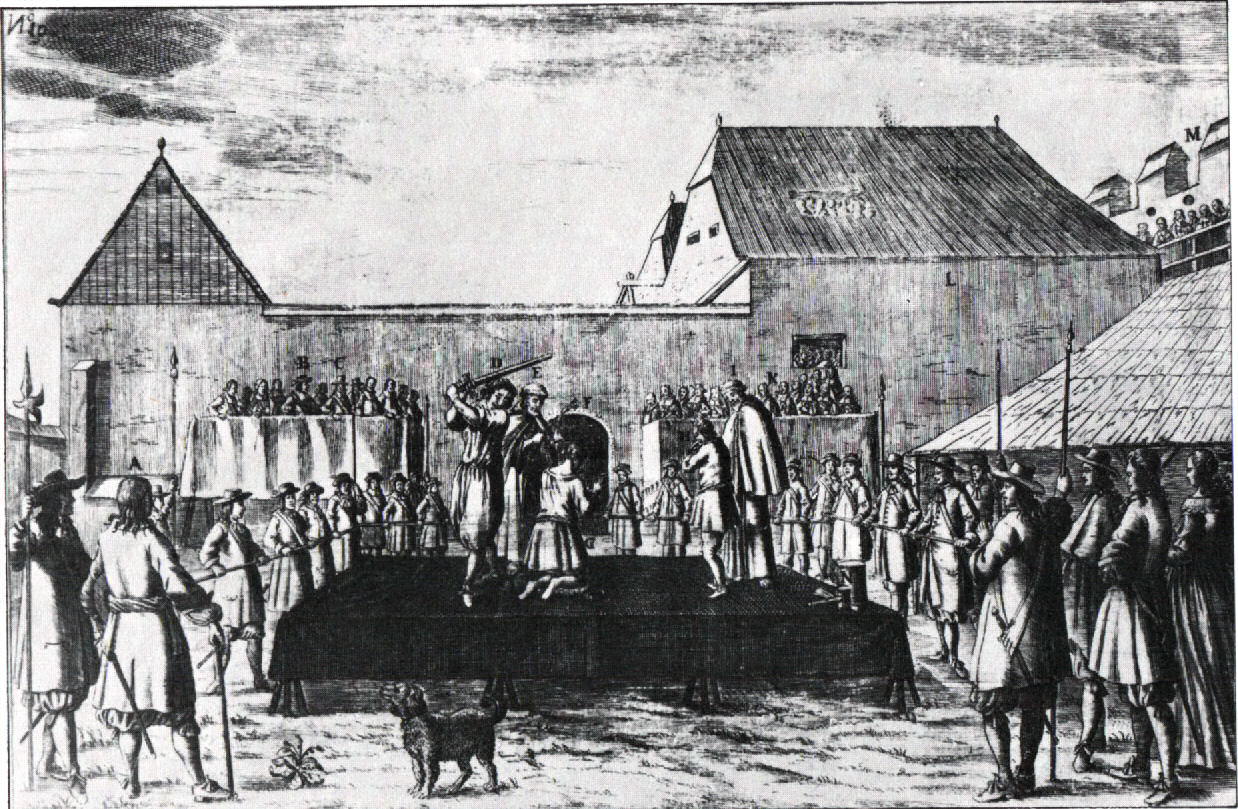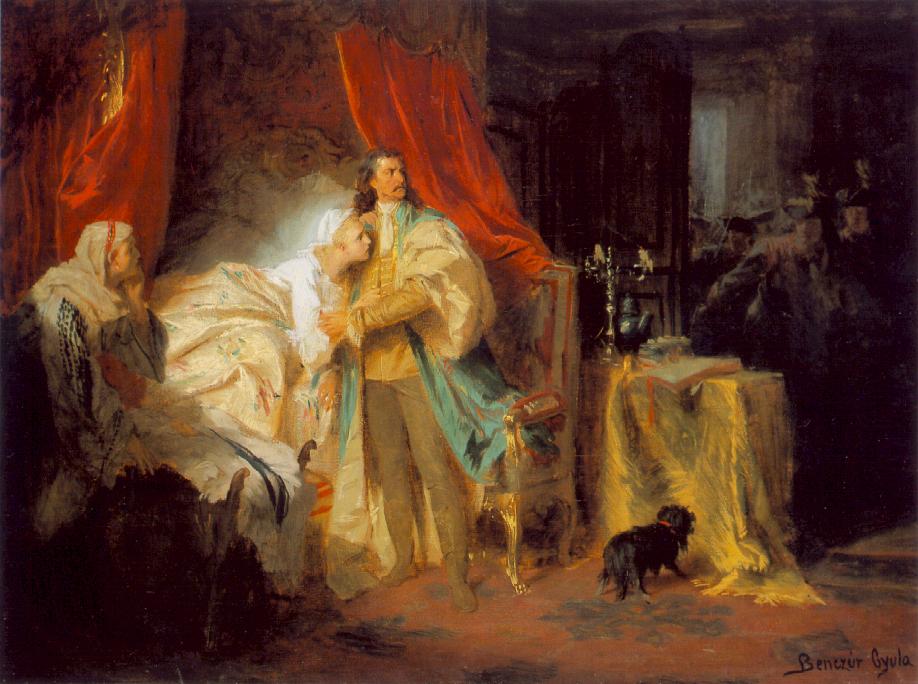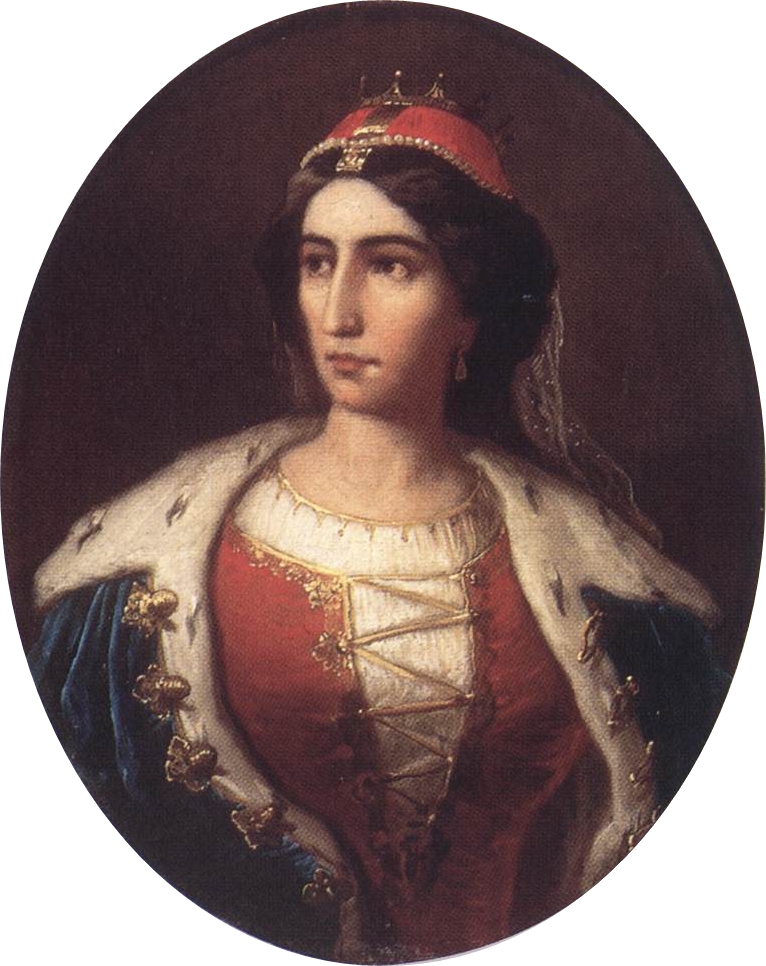|
Péter Zrínyi
Petar IV Zrinski () (6 June 1621 – 30 April 1671) was Ban of Croatia (Viceroy) from 1665 to 1670, general and a writer. A member of the Zrinski noble family, he was noted for his role in the attempted Croatian-Hungarian Magnate conspiracy to overthrow the Habsburgs, which ultimately led to his execution for high treason. Zrinski family Petar Zrinski was born in Vrbovec, a small town near Zagreb, the son of Juraj V Zrinski and Magdalena Széchy. His father Juraj VI and great-grandfather Nikola IV had been viceroys or ''Ban'' of Croatia, which was then a nominal Kingdom in personal union with the Hungarian Kingdom. His brother was the Croatian-Hungarian general and poet Miklós Zrínyi (Nikola VII Zrinski). His family had possessed large estates throughout all of Croatia and had family ties with the second largest Croatian landowners, the Frankopan family. He married Ana Katarina, the half-sister of Fran Krsto Frankopan, and they lived in large castles of Ozalj (in Centra ... [...More Info...] [...Related Items...] OR: [Wikipedia] [Google] [Baidu] |
Ban Of Croatia
Ban of Croatia () was the title of local rulers or office holders and after 1102, viceroys of Croatia. From the earliest periods of the Croatian state, some provinces were ruled by Ban (title), bans as a ruler's representative (viceroy) and supreme military commander. In the 18th century, Croatian bans eventually became the chief government officials in Croatia. They were at the head of the Ban's Government, effectively the first prime ministers of Croatia. The institution of ban persisted until the first half of the 20th century, when it was officially superseded in function by that of a parliamentary prime minister. Origin of title South Slavic ''ban'' (, with a long ), is directly attested in 10th-century Constantine VII, Constantine Porphyrogenitus' book ''De Administrando Imperio'' as ', in a chapter dedicated to Croats and the organization of their state, describing how their ban "has under his rule Krbava, Lika and Gacka." Bans during the Trpimirović dynasty Refere ... [...More Info...] [...Related Items...] OR: [Wikipedia] [Google] [Baidu] |
Magnate Conspiracy
The Magnate conspiracy (also known as the Zrinski–Frankopan Conspiracy () in Croatia, and Wesselényi conspiracy () in Hungary was a plot among Croatian and Hungarian nobles to oust the Habsburg Monarchy from Croatia and Hungary, in response to the Treaty of Vasvár in 1664. This treaty – which ended the Fourth Austro-Turkish War – was highly unpopular in the Military Frontier, and those who were involved in the conspiracy intended to reopen hostilities with the Ottoman Empire after they broke away from Habsburg rule.Magyar Régészeti, Művészettörténeti és Éremtani Társulat. ''Művészettörténeti értesítő.'' (Budapest: Akadémiai Kiadó. 1976), 27 The attempted coup against Leopold I was led by the Hungarian count Ferenc Wesselényi, the Croatian viceroy Nikola Zrinski, his brother and heir Petar Zrinski, and Petar Zrinski's brother-in-law Fran Krsto Frankopan. The Zrinski brothers and their associate Fran Krsto Frankopan were motivated, not only b ... [...More Info...] [...Related Items...] OR: [Wikipedia] [Google] [Baidu] |
Graz
Graz () is the capital of the Austrian Federal states of Austria, federal state of Styria and the List of cities and towns in Austria, second-largest city in Austria, after Vienna. On 1 January 2025, Graz had a population of 306,068 (343,461 including secondary residence). In 2023, the population of the Graz larger urban zone (LUZ) stood at 660,238. Graz is known as a city of higher education, with four colleges and four universities. Combined, the city is home to more than 60,000 students. Its historic centre (''Altstadt'') is one of the best-preserved city centres in Central Europe. In 1999, the city's historic centre was added to the UNESCO list of World Heritage Sites and in 2010 the designation was expanded to include Eggenberg Palace, Graz, Eggenberg Palace () on the western edge of the city. Graz was designated the Cultural Capital of Europe in 2003 and became a City of Culinary Delights in 2008. In addition, the city is recognized as a "Design Cities (UNESCO), Design City ... [...More Info...] [...Related Items...] OR: [Wikipedia] [Google] [Baidu] |
Francis II Rákóczi
Francis II Rákóczi (, ; 27 March 1676 – 8 April 1735) was a Hungarian nobleman and leader of the Rákóczi's War of Independence against the Habsburgs in 1703–1711 as the prince () of the Estates Confederated for Liberty of the Kingdom of Hungary. He was also Prince of Transylvania, an Imperial Prince, and a member of the Order of the Golden Fleece. Today he is considered a national hero in Hungary. His name is historically also spelled Rákóczy, in , in , in , in (, ), in , in . Although the Hungarian parliament offered Rákóczi the royal crown, he refused it, choosing instead the temporary title of the "Ruling Prince of Hungary". Rákóczi intended to bear this military-sounding title only during the anti-Habsburg war of independence. By refusing the royal crown, he proclaimed to Hungary that it was not his personal ambition that drove the war of liberation against the Habsburg dynasty. Childhood He was the richest landlord in the Kingdom of Hungary and the count (' ... [...More Info...] [...Related Items...] OR: [Wikipedia] [Google] [Baidu] |
Ilona Zrínyi
Countess Ilona Zrínyi (Croatian language, Croatian: ''Jelena Zrinska'', Hungarian language, Hungarian: ''Zrínyi Ilona'') (1643, Ozalj – 18 February 1703, Izmit) was a noblewoman and heroine. She was one of the last surviving members of the Croatian nobility, Croatian-Hungarian Zrinski, Zrinski/Zrínyi noble family. She was the daughter of Petar Zrinski, Ban of Croatia, Ban (viceroy) of Croatia, the niece of both Miklós Zrínyi and Fran Krsto Frankopan and the wife of Francis I Rákóczi, Francis Rákóczi I and Imre Thököly, as well as the mother of Francis Rákóczi II. She is remembered in history for her Defense of Palanok Castle against the Imperial army in 1685-1688, an act for which she was regarded a heroine in Hungary. Life Early years and family Ilona was born Ilona Zrínyi in Ozalj, present day Croatia. She was the eldest child of Ban of Croatia, Croatian Ban, Peter Zrinski, and his wife Katarina Zrinska née Frankopan family, Frankopan, a Croatian poet. Later ... [...More Info...] [...Related Items...] OR: [Wikipedia] [Google] [Baidu] |
Međimurje (region)
Međimurje (; ) is a small historical and geographical region in Northern Croatia comprising the area between the two large rivers, Mura and Drava, and roughly corresponding to the administrative division of Međimurje County. Overview The region consists of the alluvial plain in its southeastern part (so called or 'Lower Međimurje') and the slopes of the Alpine foothills in its northwestern part ( – 'Upper Međimurje' – or sometimes , approx. 'the Međimurje Hills'). The highest geographical point is Mohokos at above sea level. It forms part of a short hill range that extends for about across the northwestern part of the region in northwest-southeast direction. While Upper Međimurje is covered with groves, meadows, vineyards and orchards, Lower Međimurje is largely used for tillage, which includes fields of cereals, maize, potato, as well as vegetable farming. The region has been inhabited since the Neolithic and Bronze Age. From the 1st century it was und ... [...More Info...] [...Related Items...] OR: [Wikipedia] [Google] [Baidu] |
Čakovec Castle
Čakovec Castle or Zrinski Castle ( or or or ''Zrínyi-kastély'') is a medieval fortification in the middle of the town of Čakovec, the administrative seat of Međimurje County, northern Croatia. The castle is located in the Zrinski Park, not far from the city's central square, and is the biggest fortification in Međimurje County. It was constructed of hewn stone and red brick, and, during its more than 7-century-long history, subjected to several reconstructions. Today it is partly restored. The castle's main palace houses the Međimurje County Museum, the biggest museum in the county, and its atrium is also used as an outdoor theatre during the summer months. The place was the scene of the Zrinski-Frankopan conspiracy, a significant event in the history of Croatia. On 19 November 2007 Čakovec Castle was classified as a protected cultural good in the Register of Cultural Goods of Croatia under No. N-23. History The first fortification was built in the 13th centur ... [...More Info...] [...Related Items...] OR: [Wikipedia] [Google] [Baidu] |
Central Croatia
In contemporary geography, the terms Central Croatia () and Mountainous Croatia () are used to describe most of the area sometimes historically known as Croatia or Croatia proper (), one of the four historical regions of the Republic of Croatia, together with Dalmatia, Istria, and Slavonia. It is located between Slavonia in the east, the Adriatic Sea in the west, and Dalmatia to the south. The region is not officially defined, and its borders and extent are described differently by various sources. The term Central Croatia refers to the northeastern part, and the term Mountainous Croatia refers to the southwestern part of the territory; the far western part is known as the Croatian Littoral; likewise the terms 'Zagreb macroregion' and 'Rijeka macroregion' can be used instead. Central Croatia is the most significant economic area of the country, contributing well over 50% of Croatia's gross domestic product. The capital of the Republic of Croatia, Zagreb, is the largest city ... [...More Info...] [...Related Items...] OR: [Wikipedia] [Google] [Baidu] |
Ozalj Castle
Ozalj Castle ( or ''Gradina Ozalj'') is a castle in the town of Ozalj, Croatia. Description The Ozalj fortress, located on the stone cliff perched above the Kupa River, is one of the best-known fortifications of this type in Croatia. It is a very old stronghold (first mentioned in 1244) that has been converted into a castle. The popularity of this castle is because this was the joint castle of the Croatian noble families of Frankopan and Zrinski. In fact, it was the scene of the ill-fated Zrinski–Frankopan conspiracy, which significantly marked the history of Croatia. In the castle there is a museum and a library, and it is in a relatively good state of repair. History Ozalj was mentioned on 22 February 1481 in a document freeing the citizens of Grič from tariffs in Ozalj and elsewhere. At the Slavonian Sabor of June 1579 in Zagreb, the dange of leaving the river crossings at Sveti Jakov, Luka and Rečica unguarded was noted, so for their fortification the Sabor allocated ... [...More Info...] [...Related Items...] OR: [Wikipedia] [Google] [Baidu] |
Fran Krsto Frankopan
Fran Krsto Frankopan (; 4 March 1643 – 30 April 1671) was a Croatian baroque poet, nobleman and politician. He is remembered primarily for his involvement in the failed Zrinski-Frankopan conspiracy. He was a Croatian marquess, a member of the Frankopan noble family and its last male descendant. Biography Early life and poetry Born in Bosiljevo, Croatia, twenty years younger than his brothers, Fran Krsto Frankopan was an authentic poet in his own right. Following the death of his father, Vuk Krsto Frankopan, he was sent to be schooled in Zagreb, where he enrolled at the Jesuit academy. He lived at today's Habdelić street in the Upper Town, before continuing his education in Italy. There he published his first poetic work in Latin, ''Elegia'', aged 13, in 1656. During Frankopan's stay in Italy, the last member of the Roman branch of the Frangipane, Mario Frangipane decided that he wanted to leave his assets to the Veglian branch of which Frankopan belonged, and ... [...More Info...] [...Related Items...] OR: [Wikipedia] [Google] [Baidu] |
Frankopan
The House of Frankopan (, , , ) was a Croatian noble family, whose members were among the great landowner magnates and high officers of the Kingdom of Croatia in union with Hungary. The Frankopans, along with the Zrinskis, are among the most important and most famous Croatian noble families who, from the 11th to the 17th century, were very closely connected with the history of the Croatian people and Croatia. For centuries, members of these noble clans were the bearers and defenders of Croatia against the Ottomans, but also resolute opponents of the increasingly dangerous Habsburg imperial absolutism and German hegemony, which in the spirit of European mercantilism sought to consolidate throughout the Habsburg Monarchy. The past of these two clans is intertwined with marital ties, friendships and participation in almost all significant events in Croatia, especially on the battlefields in the defense of Croatia from the Ottoman conqueror. History The Frankopan family was ... [...More Info...] [...Related Items...] OR: [Wikipedia] [Google] [Baidu] |
Croatia In Personal Union With Hungary
The Kingdom of Croatia (; ; ), also known with full diplomatic name Kingdom of Croatia and Dalmatia (), entered a personal union with the Kingdom of Hungary in 1102, after a period of rule of kings from the Trpimirović and Svetoslavić dynasties and a succession crisis following the death of king Demetrius Zvonimir. With the coronation of King Coloman of Hungary as "King of Croatia and Dalmatia" in 1102 in Biograd, the realm passed to the Árpád dynasty until 1301, when the (male) line of the dynasty died out. Then, kings from the Capetian House of Anjou, who were also cognatic descendants of the Árpád kings, ruled the kingdoms. Later centuries were characterized by conflicts with the Mongols, who sacked Zagreb in 1242, competition with Venice for control over Dalmatian coastal cities, and internal warfare among Croatian nobility. Various individuals emerged during the period, such as Paul I Šubić of Bribir, who was representing the most powerful Croatian dynasty a ... [...More Info...] [...Related Items...] OR: [Wikipedia] [Google] [Baidu] |






